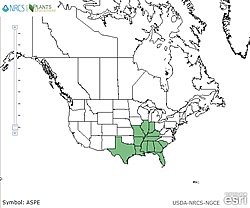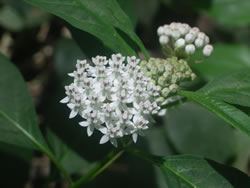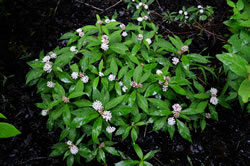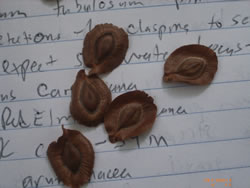Plant of the Week
 Range map of white swamp milkweed. Map from USDA PLANTS Database.
Range map of white swamp milkweed. Map from USDA PLANTS Database.
 White swamp milkweed (Asclepias perennis) flowers. Photo by Christopher David Benda.
White swamp milkweed (Asclepias perennis) flowers. Photo by Christopher David Benda.
White Swamp Milkweed (Asclepias perennis)
By Christopher David Benda
White swamp milkweed is a perennial plant in the Milkweed family (Asclepiadaceae). The genus name “Asclepias” refers to the Greek god of medicine Asklepios, while “perennis” refers to this being a perennial plant. Not to be confused with swamp milkweed (Asclepias incarnata), white swamp milkweed flowers are white and restricted to floodplain forest and along streams.
Milkweed flowers are highly specialized. The floral structure is comprised of a corona, five hoods each with one horn, and five reflexed petals. The hood is a petal-like structure that arises from the base of the filament and acts as a sheath around an inner appendage called the horn. White swamp milkweed produces an inflorescence with few flowers. Flowers bloom in mid-summer.
Leaves are opposite, slender, and taper to a point at both ends. Although widely visited by many types of insects, the plants are toxic. Cardiac glycosides are present in the milky sap and can cause rapid heart rate and general weakness. Despite this toxicity, many species of milkweeds were once used medicinally, which is why this group of plants was named after the Greek god of medicine. Few insects are adapted to tolerate this toxicity, and one example is the monarch butterfly.
The fruits are erect follicles that split along a single suture to release the seeds. The seeds of this species are unique compared to most other milkweeds, which occur in open landscapes and have fluffy seeds that are dispersed by the wind. Instead, this plant, being a denizen of swampy habitats, has winged seeds that are designed to float on the surface of the water and are dispersed with flood events.
This wetland plant occurs along the Mississippi River in Illinois and south to the Gulf, extending over to Florida.


